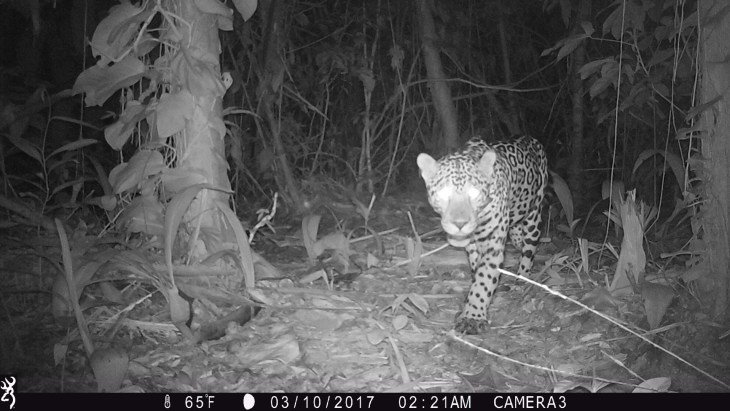Jaguars: The Divine Cats of the Mayans
Before the arrival of Europeans to the Americas, the Mayan Empire stretched across Belize, Guatemala, Honduras, and Mexico’s Yucatan Peninsula, and included great cities, such as Tulum, Chichen Itza, and Caracol. At the height of their civilization, the ancient Mayans recognized several animals as sacred, but none more so than the jaguar: the largest of the big cats in America, who still prowl the forests and ruins of the old Mayan Empire in Belize.
A jaguar relaxing at the Belize Zoo. Photo by Inspire EdVentures.
Jaguars (Panthera onca) are the only extant species of true big cats (Panthera) in the Americas, and are the third-largest big cat in the world, behind only the lion and tiger. The name jaguar comes from jaguarete in the native Paraguayan Guarani language, but amongst the Mayans are known instead as balam. For the Ancient Mayans, jaguars represented aspects of strength and hunting prowess, as well as night and death. Mayan priests revere a god also known as balam, who ruled as lord of the underworld. Because of their religious importance, jaguars were often used in ritual sacrifices, with evidence of Mayans trading and even captive breeding jaguars for this purpose.
Biology of The Jaguar
In the wild, jaguars are nocturnal hunters, preying on up to 83 individual species, including deer, tapir, and even crocodiles. Unlike most cat species, jaguars prefer to kill their prey with a single bite to the skull, using the most powerful jaws of all big cat species. Mostly solitary, a jaguar’s territory can be as large as 40 square kilometers (25 miles), with individuals meeting often only to mate. Like Leopards, Jaguars can be born with black coats due to a specific recessive genetic trait, although their spot patterns can still be seen especially in sunlight. These “black panthers” were of particular significance to Mayans, who viewed them as omens of ill-fortune or calamity.
Trail cam photos in cooperation with Sleeping Giant Resort, Belize.
Jaguars Today
Since the arrival of Europeans, and especially during the 20th and 21st centuries, jaguar numbers have diminished, especially from hunting. Before hunting was banned in 1972, as many as 18,000 jaguars were killed annually for their pelts. While once ranging from the tip of Argentina to the Southern United States, modern jaguars are extinct in much of their historic range, including the U.S, El Salvador, and Uruguay, and endangered in many others, including Mexico and the Amazon Rainforest. Although jaguars are protected in almost every country from hunting, increasing encounters with humans, as jaguar habitats shrink, has led to many jaguar deaths in retribution of jaguars attacks on livestock and, very rarely, people.
Belize, once the heart of jaguar worship under the Mayans, retains some of the healthiest populations in Central America, yet even here are threatened by habitat fragmentation, which isolates populations and threatens genetic diversity. To combat this, wildlife corridors, such as the recently established Mayan Forest Corridor, have been established to link isolated populations to one another, allowing jaguars to move freely across Belize with minimum human contact. Organizations, such as Panthera, have attempted to go even further, envisioning a single wildlife corridor that stretches from Argentina to Mexico in which jaguars and other big cats can return to much of their historic range.
Although by far the most recognizable and famous of all big cats in Central America, exact numbers of jaguars have yet to be determined in Belize. Techniques, such as identifying jaguars by their spots (each pattern as unique as a human fingerprint), can help scientists better understand jaguar populations in Belize, and establish better conservation methods to protect the futures of these beautiful and unique felines. Be sure to check out how InspireEdventures is contributing to this mission through our Research page!
Devin is a journalist and writer based in Washington, D.C. He is a graduate of SOAS University of London and Northeastern University, where he studied international politics. He writing focuses on environmental journalism, international affairs, and human rights.


